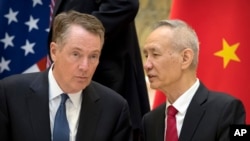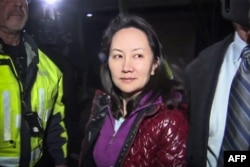As China and the United States resume high-level talks in Washington Thursday, there are signs that the two may be closing in on a deal.
Reuters news agency is reporting that top trade officials from both sides are trying to hammer out the details of six broad agreements aimed at resolving the most difficult issues from forced technology transfers, to state subsidies and cyber theft.
Earlier this week, President Donald Trump said there is no “magical date” for reaching a trade deal, a comment some felt suggests that the March 1 deadline, which could trigger a steep hike in tariffs from both countries, could be postponed if progress is being made.
Meanwhile, a senior Communist party adviser, speaking at a forum organized by the Hong Kong-based South China Morning Post, predicted Washington and Beijing would reach a trade deal in early March . He also said that Meng Wanzhou, chief financial officer of Chinese tech giant Huawei, is likely to be released by April or May.
Speaking on the sidelines of a conference hosted by the newspaper, Xie Maosong, an adjunct professor at the Central Party School, said he was confident that is what would happen because of what he called the countermeasures China had taken.
Those "countermeasures" include Bejing’s detention and charging of two Canadian citizens — Michael Kovrig and Michael Spavor — for endangering state security.
Meng is currently on bail in Canada awaiting possible extradition to the United States.
According to a Reuters report on Thursday, U.S. and Chinese negotiators are working on six broader agreements as well as a 10-item list of shorter-term measures.
Analysts tell VOA, that while it appears a more comprehensive deal is coming together, the details of any agreement will be key in determining whether it is a success or just an opportunity to kick long-standing issues down the road.
Christopher Balding, an economist and associate professor at Fulbright University Vietnam, said deals like the one China and the United States are working on take time.
There will be a lot of paperwork and time spent making sure individual agreements for industries are worked out, he said.
“The other issue that is going to be the real hang up, and this is going to be the real hang up for Beijing, is that there is some type of verification mechanism,” Balding said. “It’s not just the agreement, but what comes after the agreement.”
William Choong, a senior fellow with the International Institute for Strategic Studies in Singapore, said while they are two entirely different issues, the way President Trump is handling China is similar to how he is working with North Korea.
Choong said much like the meeting between Kim Jong Un and Trump in Singapore led to a North Korea deal 1.0, next week we’re going to get a 2.0 deal with North Korea in Vietnam.
The trade deal that is coming up is similar, he said.
“It will not be the all and end all. We are going to see more iterations along the road,” Choong said. “Whatever agreement they settle on, that the Americans and Chinese agree on, will be enough to let go of some of the steam, some of the pressure that has built up.”
That will give Trump a chance to kick the March 1 deadline further down the road, he added.
Chinese state media reports on Thursday were upbeat about the meetings.
An editorial in the China Daily, entitled “Decisive Talks Must be Forward Thinking,” said, “both sides should cherish the narrowing of their differences that has been achieved, as it has involved more than just picking off low-hanging fruit.”
Calling President Trump’s suggestion that the deadline could be delayed a “conciliatory signal,” the paper also added that it would be “naïve to think that such a Gordian knot of differing goals and ambitions will be simple to unravel, especially as the discussions are now about the most divisive and touch-a-nerve issues.”
It also said Washington needs to be realistic about what China can and cannot do. What that actually entails will only be clearer when the complete agreement is released.
“China more than anything wants this to go away because it is hindering a lot of their confidence building measures and investment decisions, that’s what they are really hoping to get out of it [a deal],” Balding said.
Choong agrees, noting that what Beijing wants is to get Trump off its back. But, he added, how China could change course enough on issues such as forced technology transfers is unclear.
“I do not know how the Chinese are going to put something that is significant enough in the agreement to actually placate the Americans,” Choong said. The Chinese, he said, are looking for a way to play Trump, much like North Korea has done.
“If Trump gets enough on paper that looks satisfactory, he can go away to the Twitter-verse and say look I’ve got this big deal with the Chinese.”








